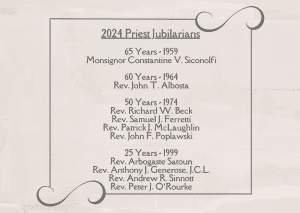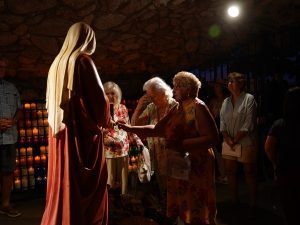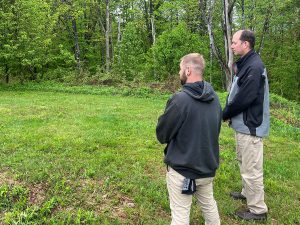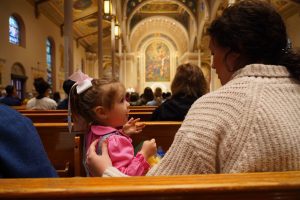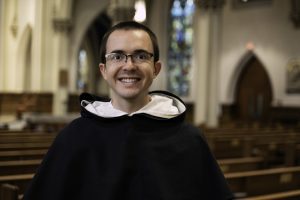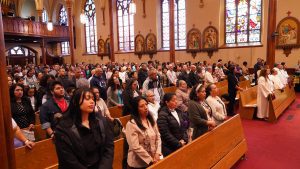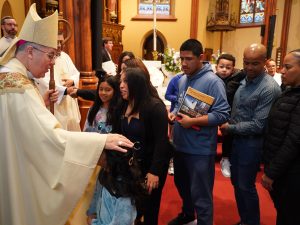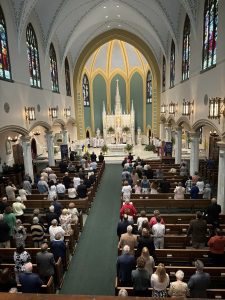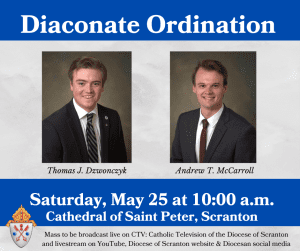
SCRANTON – With their Diaconate Ordination just days away, both Andrew McCarroll and Tom Dzwonczyk have had many people congratulating them about their “big day.”
Both men are quick to say the Ordination Mass, planned for May 25, is not about them.
“It is not my big day. It is the church’s big day. Everything that is happening is affirming the ministry that I’m doing for them,” McCarroll said. “I’m being ordained for the people, for service to them. That is an image that is very profound to me as I’m preparing these next few days.”
“It is not about anything we’ve done. It’s about the Lord and what He is doing through me and through everyone He is calling,” Dzwonczyk added. “It is 100-percent about God and what he is doing in his Church.”
Dzwonczyk and McCarroll will begin the final step in their formation for the priesthood when they are ordained to the transitional diaconate by the Most Rev. Joseph C. Bambera, Bishop of Scranton, on May 25 at 10:00 a.m. at the Cathedral of Saint Peter in Scranton.
All are welcome to attend and participate in the celebration.
Ordination as a transitional deacon generally occurs after a seminarian has completed at least three years of study in theology and takes place usually one year prior to priestly ordination. A Deacon can be an ordinary minister of Baptism, and will be able to preside at weddings, assist the priest at Mass, proclaim the Gospel and preach, as well as preside at wakes and funeral services.
Dzwonczyk, 26, is the son of Thomas and Stephanie Dzwonczyk of North Abington Township, Lackawanna County. He attended Holy Cross High School in Dunmore and just completed Theology III at Saint Mary’s Seminary and University in Baltimore, Md. During his discernment process, Dzwonczyk completed a pastoral year assignment at Saint Jude Parish, Mountain Top, where he also assisted teaching eighth grade religion at Saint Jude School. He has one younger sister, Katherine, and grew up attending Saint John Vianney Parish in Montdale.
McCarroll, 25, is the son of Todd and Judy McCarroll of Lehman, Luzerne County. He attended Holy Redeemer High School in Wilkes-Barre, Saint John’s University in Queens and has been attending Saint Mary’s Seminary and University in Baltimore, Md. McCarroll is participating in his pastoral year right now at Saint Boniface Parish, Williamsport, and Saint Lawrence Parish, South Williamsport, and is also serving as Director of Religious Formation at Saint John Neumann Regional Academy. He has two brothers, Nicholas and Will, and has a home parish of Saint Robert Bellarmine in Wilkes-Barre.
While both men say while their studies and experiences have prepared them to become Deacons at the end of the month, they admit feeling both excitement and nervousness.
“I’m very excited. It seems like when I first entered seminary it would never get here, it seemed very far away, and now to think that I’m on the doorstep of it, is pretty incredible,” Dzwonczyk said. “I’m also very nervous. I would imagine that this is how people feel before they’re about to get married, very nervous recognizing the weight of the commitment, but I’ve also been feeling great peace in my prayer and in the conversations with my brothers at the seminary.”
“It is a big step so there is some anxiety about it, which I think is a good sign, because it’s a very natural sign, but it’s coming out of excitement,” McCarroll added. “I’m excited to serve and minister in a new way, a way that I’ve been preparing for.”
Once ordained a deacon, McCarroll is looking forward to preaching at Mass. His first experience will come the same day as his Ordination – May 25 – as he will preach the 4 p.m. Vigil Mass at Saint Robert Bellarmine Parish.
“I’m really looking to take the Scriptures and really bring them to life. It is a moment for growth and it is a challenge,” he said. “I’m excited for the challenge to grow in that way.”
Dzwonczyk says he is particularly moved by the Sacrament of Baptism and is looking forward to being able to baptize his first child.
“I always marvel at the grace that comes in baptism. It’s a simple act – pouring water on someone’s head – and yet the spiritual effect that it has never ceases to amaze me,” he explained.
Dzwonczyk will deliver his first homily as a deacon on Sunday, May 26, at 11:00 a.m., at his home parish of Saint John Vianney in Montdale.
“I’m a little nervous. It’s my first time preaching and it’s Trinity Sunday, so it’s not the easiest topic to preach on,” he joked.
As they look forward to their Ordination Mass, both men want to express their gratitude to all of the people who have helped them on their discernment journey – or simply prayed for them through the process.
“The number of people who have reached out to me, just saying they’re praying for me or they’re thinking about me, or who have reached out to my parents is just overwhelming and I’m truly humbled,” Dzwonczyk said. “Truly, without their prayers, I wouldn’t have made it.”
“I trust God, that he is present in all of this, and that he is guiding me every step of the way,” McCarroll added.
For anyone unable to attend the Ordination Mass in person, CTV: Catholic Television of the Diocese of Scranton will provide a live broadcast as well as livestream the Mass on the Diocese of Scranton website, YouTube channel and all social media channels.

